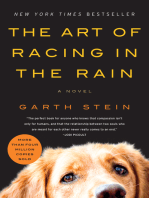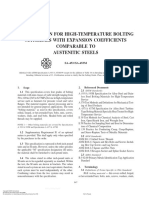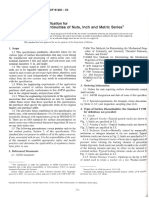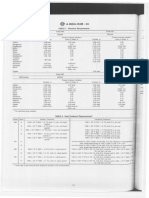0 ratings0% found this document useful (0 votes)
20 viewsUntitled
Untitled
Uploaded by
Jay GaneshCopyright:
© All Rights Reserved
Available Formats
Download as PDF or read online from Scribd
Untitled
Untitled
Uploaded by
Jay Ganesh0 ratings0% found this document useful (0 votes)
20 views5 pagesCopyright
© © All Rights Reserved
Available Formats
PDF or read online from Scribd
Share this document
Did you find this document useful?
Is this content inappropriate?
Copyright:
© All Rights Reserved
Available Formats
Download as PDF or read online from Scribd
Download as pdf
0 ratings0% found this document useful (0 votes)
20 views5 pagesUntitled
Untitled
Uploaded by
Jay GaneshCopyright:
© All Rights Reserved
Available Formats
Download as PDF or read online from Scribd
Download as pdf
You are on page 1of 5
Ally Designation: 8 695 - 04
7
# wueruu
Standard Specification for
Coatings of Zinc Mechanically Deposited on Iron and Steel"
att tgs oe eesti era nha eis
Smo ei ics ctrl cap si nit tater oe
dhs ben part esis of te ayer fone
1. Seape
1.1 This specification covers the requitements for a coating
of zine mechanically deposited on iron and stoe basis metals
‘The coating is provided in several thicknesses up to and
including 107 um. ‘The seven thickest classes are usually
referred to 48 “mechatically galvanized.”
1.2 This standard does not purport to address all of the
safety concerns, if any, associated with ity use. It Is the
responsiblity af the user of this standard to establish appro
priate safety and health practices and determine the applica-
bility of regulatory limitations prior to use
‘ors 1—The performanes ofthe coating complies with the requis
men of Spiel A LSWA 153M and MOL-C81502,
1.3 The values stated jn SI units are to be regarded as the
dard. The inch-pound equivelents of St units are given for
rational purposes,
2. Referenced Documents
2.1 ASTI Standards: =
‘ASMA 153M Specification for Zine Costing (Hor-Dip)
‘on ron and Steel Hardware
A.DMIA 194M Specification for Carbon and Alloy Steel
‘Nuts for Bolts for High Pressure or High Temperstuze
Serviee, oF Both
A325 Specification for Structural Bolts, Steel,
‘Freated, 120/105 ksi Mininauea Tensile Strength
A490 Specification for Heas-Treated, Stee! Structural
Bolts, 150 ksi Minimum Tensile Strength
A-563 Specification for Carbon and Alloy Steol Nuss
B17 Practice for Operating Sult Spray (Foy) Apparatus
Heat
B 183 Practice for Preparation of Low-Carbow Steel for
‘lccrrplatin
1B 242 Practice for Preparation of Migh-Carbon Stee! for
‘Electroplating
"us spectinton it unde he junio of ASTM. Commitee Ba on
‘Menlle a5 Ig Canngsand i th ist espe of Strom
DON on at Meta
‘are: eben proved Avg, 1, 208% Pobited August 2008, Orgy
anavat 1H Lat reso lon aor 300 36 B50.
Gar rfid AS atin vit tho ASTM meth wrt
‘tet ASTD Castner Sac at even foal atk of AST
‘Savane faz, retro th son's Dement Samay page =
1B 322 Guide for Cleaning Metuls Prior to Electroplating
1348) Test Method for Measurement of Metal and Oxide
‘Coating Thickness by Microscopical Examination of a
Cross Section
8499 "Test Method for Measurement of Coating Thick-
‘nesses by the Magnetic Method: Nonmaygetie Coatings on
Magnetic Basis Metals
B71 Practice for Qualitative,Adhesion Testing of Metall
Coatings
8 602 Test Method for Aribute Sampling of Mette ond,
Trorganic Coatings
B 697 Guide for Selection of Sumpliny Plins for Iaspection
of Blectrodeposited Metalliciand Inorganic Coatings
B 762 Test Method of Vuriubles Sampling of Metallic and
Inorganic Coatings
F 1470 Guide for Fastener Sarnpling for Specified Mecha
cal Properties and Performance Inspection
22 Military Standard,
WAL-C-81562 Coating, Cadmium, Tin Cadmium
(Mechanically Deposited)?
23. AISC Standard:
Specifications for Structural Joints Using ASTM A 325 or
‘4 490 Bois!
and Zine
3, Cssifiation
3.1 Classes—Zine caatings ate classified on the basis of
thickness, as follows:
oes Mien Takes um
30 a
2 a
= 2
: 5
32 Types-—Zine coatings are identified by types vn the
‘bess of supplementary westment required, as fellows:
Sl he Stns Dace Or Des, DODSS, At
“Tarmac tet Stel Ca
washer De Sat 0, Chia ae
(180), On
Conn DAG ama 2 a Hari, Ho 7B, a enn PRESS Ui
P. 003/007
ffly B 695-04
‘Type I-As coated, without supplementary weatment (Ap
pendix X2.0)
‘Type Il—With colored chromate conversion treatment (Ap-
pendix X2.2,
4 Ordering Tatormation
411 Supplying the following infomation by te pashaser 0
the veer nthe purchase order oruther governing Gosurent
make the application ofthis specification complete:
1 Clas, neaing x maximum hikes. if appropiate,
‘ype and for Type color an8 need for supper aisant
G33, and 62.5),
{lh Nature of stbstrate (or example, highest sted,
seed forse rlicf (62.1), and cleaning prcautons #0 be
followed (522 and 6.
1413 Significant srfaees (6.3),
S.L4 Requirements for and mathods of testing fr one ot
snow of the following, required: nesd for and typeof est
sperimns (8.1), thks (63 and 83), adhesion (64 ad
Es), corrosion resistance (6.5 and 8.5), absence of hydrogen
enitlement, td the wailing eri before resting and testing
Toads (66 and 66),
4LL5 Inspection responsibility (Section 11) and sampling
alan for cath inspection enilerion (Section 7) and
41.6 Reauirements for cored report of fest resis (Seo
tion 10)
5. Workmanship
5.1 The costing shull be uniform in appearance and free of
blisters, pis, nodules, flaking, and other defects tit wre
capable of adversely affecting the function ofthe coating. The
coating shall cover all surfaces as stated in 6.3 including roots,
of threads, thread peaks, corners, recesses, and edges. The
outing shall not be stained oF discolored throughout to am
extent capable of adverscly affecting appearance as a func-
tional requirement, However, auperical staining, that results
from ringing or drying, and variations in color of luster shall
not be eause for ecjestion,
Nom 2The matte of the mechercal plating roses iv wl it
couting charsrrseally wll aot bea smooth or 38 eigit some
ed cong
6, Requirements
6.1 Appearance —The coating a5 deposited shall hive a
uniform silvery appenince, and a mate to medium-bright
fuster,
6.2. Process
62.1 Stress-Rellef Troatment—All steel parts that have an
ultimate tensile strengel of 1000 MPs and above and that
contain tensile stresses caused by machining, grinding,
struightening, or cold-forring operation shall be given a
ssressrclif heat treatment prior to cleaning and metal deposi
tion, The temperature and time at temperature shall be 190 =
18°C for n minimum of 3 h so that maxinum stress relief is
obtained swithout reducing the hardness below the specified
6.2.2 High-strength steels (which become embritled when
charged with hydrogen) and that have heavy oxide or seale
sll be cleaned before application ofthe coating in accordance
with Practice B242. In general, nonelectralyie alkaline,
anodic-alkaline, ad some inhibited acid cleaners are prefered
{ovoid the risk of producing hydrogen embittemem ian the
cleaning procedure.
62.3 For low-carbon steels, see Practice B 183. Useful
ines are alse given in Guide B 322
62.4 Mechanical deposition of zie eoutings sball consist
in general, ofall of the steps listed inclow, and in the sequence
es shown:
62.4.1 Preparation of the surfuce of the purts to be eoaed
by chemical (generally acidic) procedure to an extent that
emits uniformly satisfactory results Som subsequent steps.
6242 Deposition of a thin metal costing, yenerally of
‘vopper, by immersion in upproptate chemival solutions, with-
ut the use af eleetie current. There arc no thickness xequire+
‘ments for this eowi
3. Tumbling of the pus that have becn treated accord
1g 10 6.2.4.1 and 6.2.42 in a containce withthe following:
(1) The zine metal wo be deposited, in powder form:
(Q) Impact media, which includes glass, for example, er
other substances thar are essentially inet so the chemicals of
the deposition process, Ths function of this medi isto aid in
providing mechanical forces to drive the metal powder onto the
substrate parts;
(3) A “promoter” or “accelerator” which aids ia the
‘uniform deposition af the metal powder; and
4) A liquid medium, generally water
6.2.44 Separation of the pets fram the solid and liquid
media
62.45 Rinsing,
62.48 Drying,
52.5 Supplententary Treatments
6258.1 Colored Chromate Conversion Trearments. (Tipe
‘U}—Colveed chromate conversion treatment foe Type T shal
be done in a solution containing hexavalent dérastium ions.
“This solution shall produce a bright or sens-bright continues
smooth, protective film with a unifoer color that is capable of
ranging fiom yellow through bronze and olive-dmb to brown
tnd black and that are capable of being dyed toa desired coer
Bright dips that do not contain salts that yield films eontinin
hhexavalont chremiam ions sre precluded as tostments for
producing ype Il coatings
2 Waes, lacquers, or other organic coatings are not
prohibited from ticing nsed to improve lubricity, end the need
For them shall be supplied in the purchase order or other
goweming document (See 4.1.1). Supplemental lubrication
Hreqecents bull not be used to ensure eoslormance to the sult
spray corrosion resistance requirements (see 8.5).
62.5.3 Lubrication of grade DH nuts processed in accor
with this specification und wed with Specification A 32:
rength bolts is a requirement of paragraph 6.5 of
Specification A325 and paragraph 4,8 of Specification A 563,
Nore 3--Although sot inhaled in Specification A 196/A.195%4 hin
provision should apply to mechanically gaivanasd A 1924 ms whe
Supplie fora with Speitcation A328 bal
‘Nurs 4—Speifations for sirscwrl joints wing Specifienion 0325
or AA99 hole eferonees the tte of seater WEE ih
Specifeaton A325 higatreagth bol ad is und inthe commentary on
P.ana/o07
Athy 8 695-04
‘hic RCSC (Reseurt Coun on Swactual Connections of te Engines
‘ng Fooncatin) SpeiReatio, within the paragraphs ented "Elect OF
Gaivaniing Upum Torus {valves In Tigening™ aod "Skipping Res
‘piements For Galvusied Bolts apd Wut” pubiahed November 1985,
page 30
62.6 Surface Defects—Defects and variations in uppear-
ance in the costing that arise from sueface conditions of the
substrate (serathes pores, roll marks, inclusions, ete.) and tbat
persist in the finish despite the observunce of good metal
finishing practices shall not be eause for rejectian.
‘Nore Applic fines gency perfor beter in sevice when the
sulitate over which ley ae apliog is smoot ard fre of lemme
inelsion, pore and other defect. tf rcominended that he spec
tins covering te fined pret provide it fr these dec. A
tna for ea eflon rertove defect through spec Westnet ic
Sr ghading, paling, wave Bnsting,
You might also like
- The Subtle Art of Not Giving a F*ck: A Counterintuitive Approach to Living a Good LifeFrom EverandThe Subtle Art of Not Giving a F*ck: A Counterintuitive Approach to Living a Good LifeRating: 4 out of 5 stars4/5 (5980)
- The Gifts of Imperfection: Let Go of Who You Think You're Supposed to Be and Embrace Who You AreFrom EverandThe Gifts of Imperfection: Let Go of Who You Think You're Supposed to Be and Embrace Who You AreRating: 4 out of 5 stars4/5 (1112)
- Never Split the Difference: Negotiating As If Your Life Depended On ItFrom EverandNever Split the Difference: Negotiating As If Your Life Depended On ItRating: 4.5 out of 5 stars4.5/5 (898)
- Grit: The Power of Passion and PerseveranceFrom EverandGrit: The Power of Passion and PerseveranceRating: 4 out of 5 stars4/5 (619)
- Hidden Figures: The American Dream and the Untold Story of the Black Women Mathematicians Who Helped Win the Space RaceFrom EverandHidden Figures: The American Dream and the Untold Story of the Black Women Mathematicians Who Helped Win the Space RaceRating: 4 out of 5 stars4/5 (932)
- Shoe Dog: A Memoir by the Creator of NikeFrom EverandShoe Dog: A Memoir by the Creator of NikeRating: 4.5 out of 5 stars4.5/5 (546)
- The Hard Thing About Hard Things: Building a Business When There Are No Easy AnswersFrom EverandThe Hard Thing About Hard Things: Building a Business When There Are No Easy AnswersRating: 4.5 out of 5 stars4.5/5 (356)
- Her Body and Other Parties: StoriesFrom EverandHer Body and Other Parties: StoriesRating: 4 out of 5 stars4/5 (831)
- Elon Musk: Tesla, SpaceX, and the Quest for a Fantastic FutureFrom EverandElon Musk: Tesla, SpaceX, and the Quest for a Fantastic FutureRating: 4.5 out of 5 stars4.5/5 (476)
- The Emperor of All Maladies: A Biography of CancerFrom EverandThe Emperor of All Maladies: A Biography of CancerRating: 4.5 out of 5 stars4.5/5 (275)
- The Little Book of Hygge: Danish Secrets to Happy LivingFrom EverandThe Little Book of Hygge: Danish Secrets to Happy LivingRating: 3.5 out of 5 stars3.5/5 (424)
- The World Is Flat 3.0: A Brief History of the Twenty-first CenturyFrom EverandThe World Is Flat 3.0: A Brief History of the Twenty-first CenturyRating: 3.5 out of 5 stars3.5/5 (2272)
- The Yellow House: A Memoir (2019 National Book Award Winner)From EverandThe Yellow House: A Memoir (2019 National Book Award Winner)Rating: 4 out of 5 stars4/5 (99)
- Devil in the Grove: Thurgood Marshall, the Groveland Boys, and the Dawn of a New AmericaFrom EverandDevil in the Grove: Thurgood Marshall, the Groveland Boys, and the Dawn of a New AmericaRating: 4.5 out of 5 stars4.5/5 (270)
- The Sympathizer: A Novel (Pulitzer Prize for Fiction)From EverandThe Sympathizer: A Novel (Pulitzer Prize for Fiction)Rating: 4.5 out of 5 stars4.5/5 (125)
- Team of Rivals: The Political Genius of Abraham LincolnFrom EverandTeam of Rivals: The Political Genius of Abraham LincolnRating: 4.5 out of 5 stars4.5/5 (235)
- A Heartbreaking Work Of Staggering Genius: A Memoir Based on a True StoryFrom EverandA Heartbreaking Work Of Staggering Genius: A Memoir Based on a True StoryRating: 3.5 out of 5 stars3.5/5 (232)
- On Fire: The (Burning) Case for a Green New DealFrom EverandOn Fire: The (Burning) Case for a Green New DealRating: 4 out of 5 stars4/5 (75)
- The Unwinding: An Inner History of the New AmericaFrom EverandThe Unwinding: An Inner History of the New AmericaRating: 4 out of 5 stars4/5 (45)
- Steel Bars, Carbon, Hot-Wrought, Special Quality, Mechanical PropertiesDocument4 pagesSteel Bars, Carbon, Hot-Wrought, Special Quality, Mechanical PropertiesJay GaneshNo ratings yet
- UntitledDocument6 pagesUntitledJay GaneshNo ratings yet
- Specification For High-Temperature Bolting Materials With Expansion Coefficients Comparable To Austenitic SteelsDocument10 pagesSpecification For High-Temperature Bolting Materials With Expansion Coefficients Comparable To Austenitic SteelsJay GaneshNo ratings yet
- UntitledDocument5 pagesUntitledJay GaneshNo ratings yet
- Structural Bolts, Steel, Heat Treated, 120/105 Ksi Minimum Tensile StrengthDocument8 pagesStructural Bolts, Steel, Heat Treated, 120/105 Ksi Minimum Tensile StrengthJay GaneshNo ratings yet
- A453 SpecnDocument2 pagesA453 SpecnJay GaneshNo ratings yet
- A320A320MDocument8 pagesA320A320MJay GaneshNo ratings yet
- Iso 10684Document26 pagesIso 10684Jay GaneshNo ratings yet
- A193A193MDocument13 pagesA193A193MJay GaneshNo ratings yet

















































